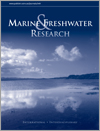Marine and Freshwater Research
Volume 74
Number 4 2023
Fisheries catches in the Indian Ocean have increased consistently since 1950, in contrast to declines observed in other oceans. Small-scale fisheries, accounting for 40% of catches, have grown consistently since 1950, whereas industrial fisheries have flatlined since the late 1990s, despite strongly growing fishing intensity. Indian Ocean countries dominate catches, whereas distant water fleets from other areas of the world account for a much small share. The combination of slowly growing catches despite strongly increasing fishing intensity suggests declining fish abundances, reinforcing sustainability concerns.
The discarding of recreational fish-cleaning waste back into waterways is a common practice, and these resources are scavenged by several species. We show that the movements of a common consumer, the smooth stingray, are strongly linked to when and where this activity occurs. Foraging of provisioned resources has various impacts for wildlife. Therefore, improved management of discard practices for recreational fishing is recommended.
The Western Rock Lobster fishery is recognised to be a conservatively managed fishery. However, anecdotal reports from commercial fishers identified an area of unexpectedly low catches. This study conducted an intensive mark–recapture survey over 8 months to explore this low-catch zone. We found a decreased abundance of sublegal lobsters, but consistent abundance of adults, indicating a hyper-stability of fishing catches, owing to fishers adapting to perceived low catch rates. This study provides a valuable baseline for further research.
The current study found a noticeably higher diversity of polychaetes in the soft bottom of the Eastern Harbour than have previous studies in this harbour. In total, 54 polychaete species were found; 11 of these were alien species, including 4 new to the Mediterranean Sea (Caulleriella cristata, Armandia casuarina, Spio blakei and Prionospio lighti). Long-term eutrophication has caused significant changes in the composition and abundance of the soft-bottom polychaete community in the Eastern Harbour of Alexandria.
Coastal and estuarine finfish species are responding to human-induced climate change by altering their distribution. In tropical regions, the species mostly affected by warming have limited acclimation capacity or live close to their upper thermal limits. Consequently, coastal fish assemblages may dramatically contract in range, experience declining population abundance or local extinction. We use habitat-suitability models to predict the distribution of species in the current (2004–2019) and future (2015–2100) time periods. The predictions inform conservation and fisheries management.
Marine sedentary species have a heterogeneous distribution according to their biological characteristic, environment and exploitation patterns. Spatio-temporal data for the gastropod queen conch (Aliger gigas) were analysed by means of spatial analysis and a depensation model. This analysis was to determine the presence of source–sink configuration and Allee effect, which reduces their ability to find mates at low densities. The identification of these can reduce the overestimation of stock productivity and reduce the disparity between biological and management units.
We used a combination of stable-isotope analysis and acoustic telemetry to validate whether variation in stable-isotope values correlated with acoustically tracked migration patterns and to examine size-based and sex-specific variation in non-breeding season movements at the population level. We found evidence of differential migration patterns and sexual segregation among six clusters of Port Jackson sharks, suggesting that individuals may modulate their migratory behaviour for different reproductive-fitness benefits.
A team of wetland ecologists and local Wurundjeri Woi Wurrung Narrap (‘Country’) Rangers surveyed understorey vegetation and the condition and reproductive output of remnant river red gums (Eucalyptus camaldulensis) in response to different levels of flooding across several degraded urban billabongs. Our study illustrated how regular flooding and Traditional Owner involvement promotes the restoration of ecological and cultural values of billabongs.





